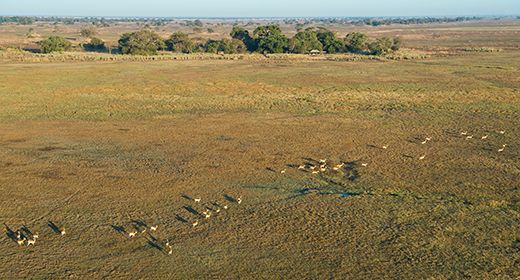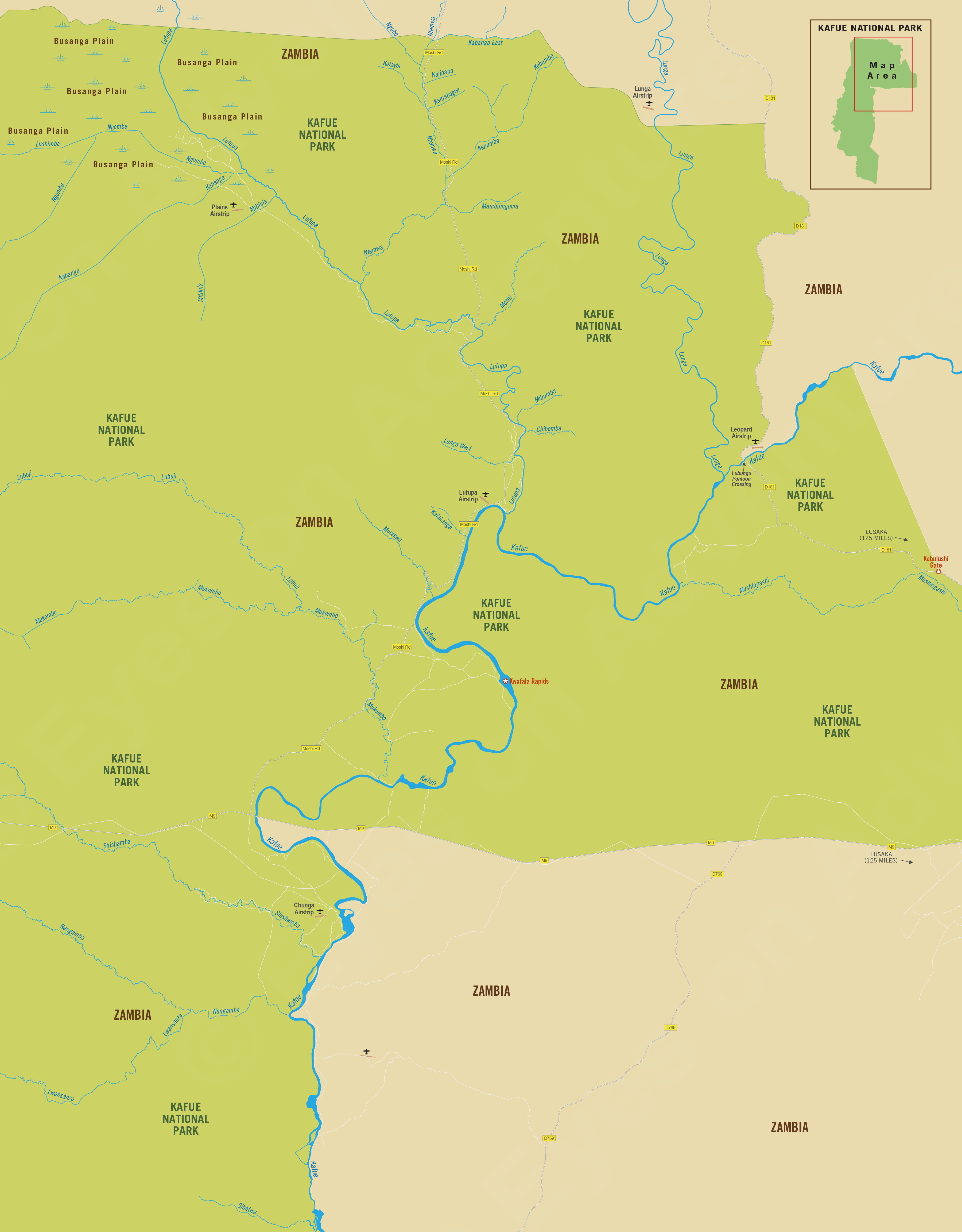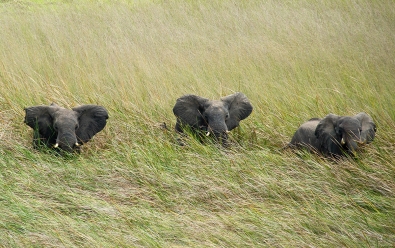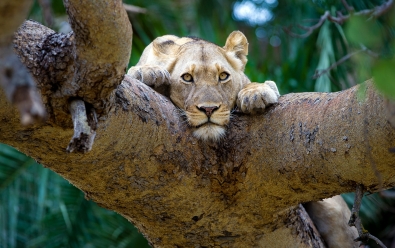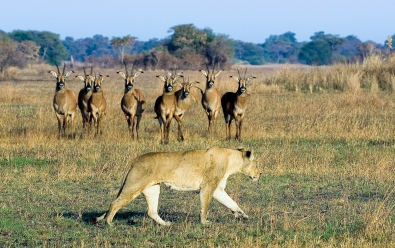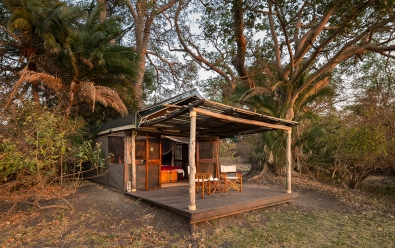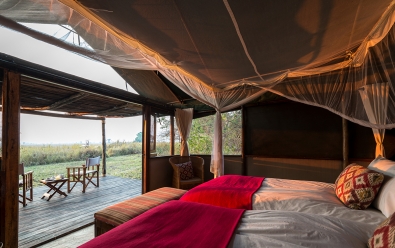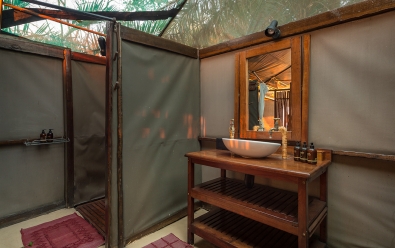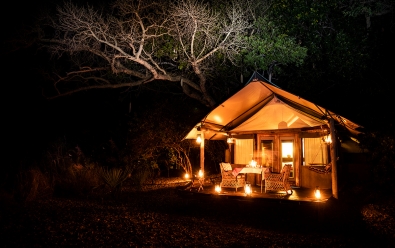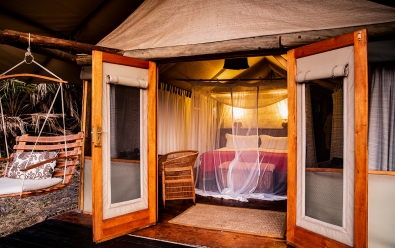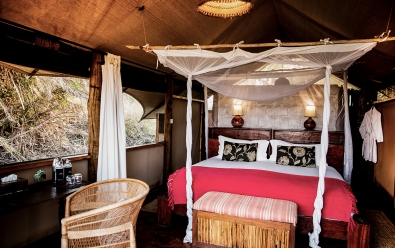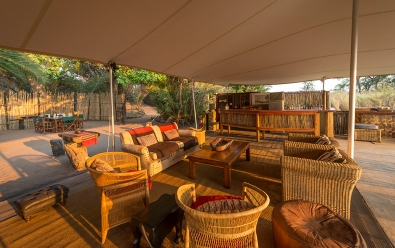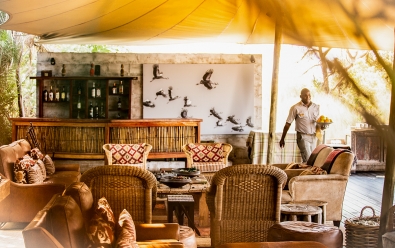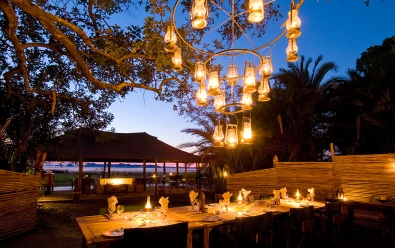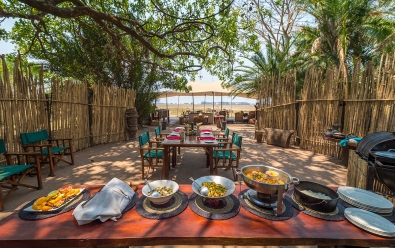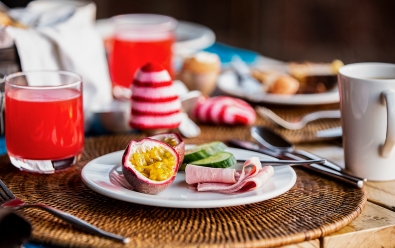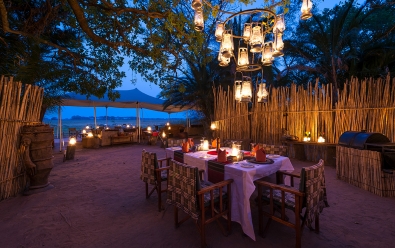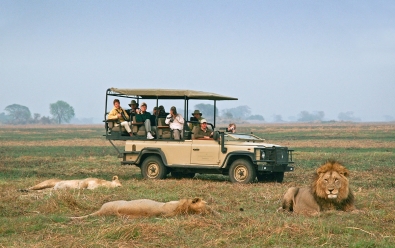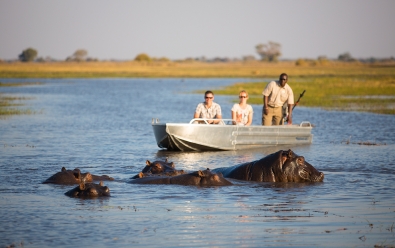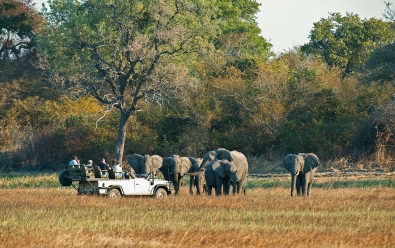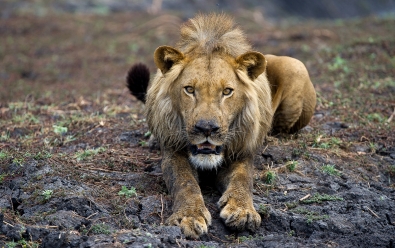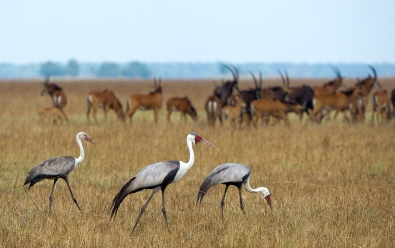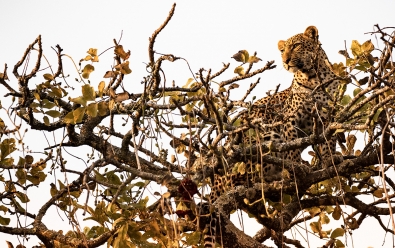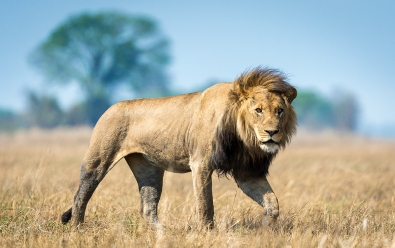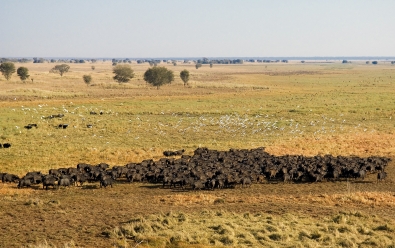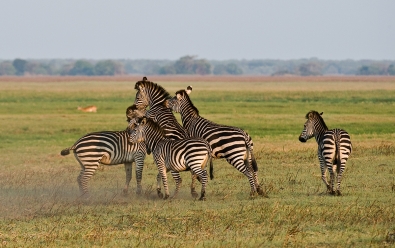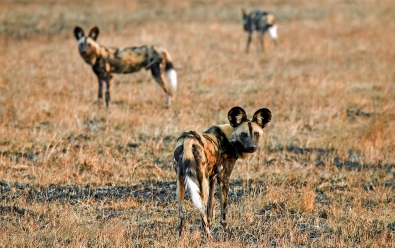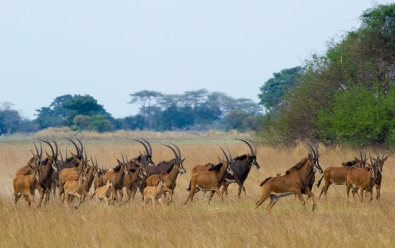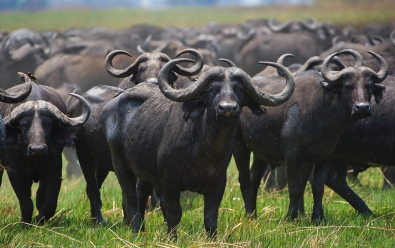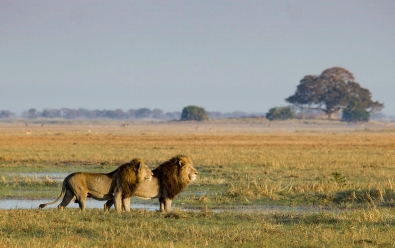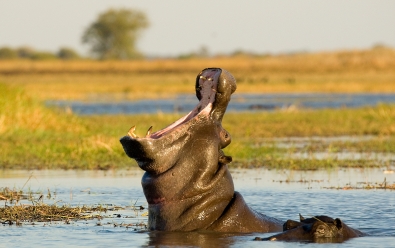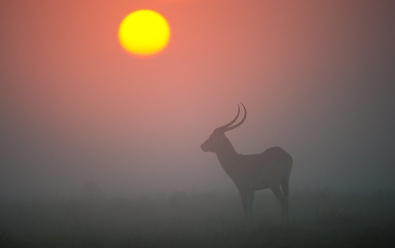Busanga Bush Camp
Inquire for lodging prices
Highlights
- Seasonally superb wildlife viewing during dry season
- Spectacular setting in one of Africa's great wetlands
- A true wilderness where large herds of herbivores roam the plains
- Good variety of wildlife species, including lion and cheetah
Location
- Kafue National Park (Northern)
- Busanga Plains
- Southwest Zambia
Busanga Bush Camp is located in the Busanga Plains, a seasonally inundated grassland in northern Kafue National Park that becomes full of wildlife during the dry season.
Northern Kafue offers an exceptional safari experience for five months (June through October) every year after the annual flooding has receded. The inundation of the Busanga floodplains brings in rich sediments from the overflowing waterways and as the water recedes, the nutrient-rich soil creates a verdant grassland that attracts large herds of herbivores.
Beginning in June, the dynamic ecosystem of the 230-square-mile (600-sq-km) Busanga Plains is accessible for safari game drives and there are few places in Africa that can match it for large herds and predators. During June and July (depending on the early-season water levels), Busanga Bush Camp also offers boating in flat-bottom boats to explore the plains.
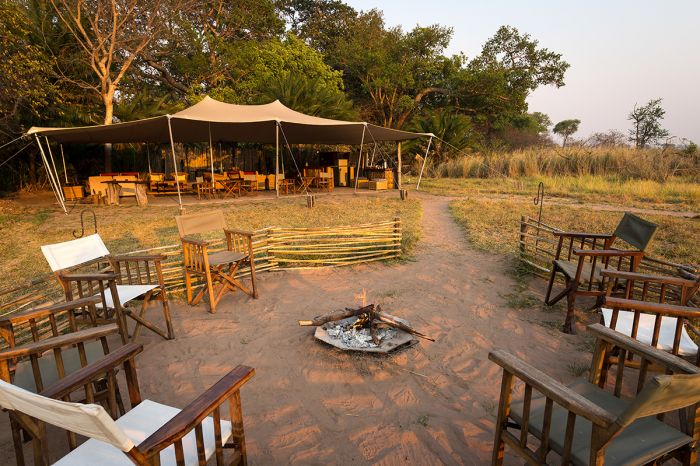
Main area at Busanga Bush Camp.
Wildlife viewing at Busanga Bush Camp is excellent with big herds of buffalo and good numbers of zebra, red lechwe, puku, oribi, blue wildebeest, roan antelope, sable antelope, greater kudu, and Lichtenstein’s hartebeest.
The open plains of Busanga are well-suited for cheetah and they are seen regularly at Busanga Bush. Other predators that are seen include spotted hyena, side-striped jackal, serval, and African wild dog. Leopard are also here and sometimes seen.
Birding in the Busanga area is outstanding, with a large mix of grassland and water species. A typical day on safari at Shumba may produce 60-70 species and there are some specials to be seen, such as Fülleborn's longclaw.
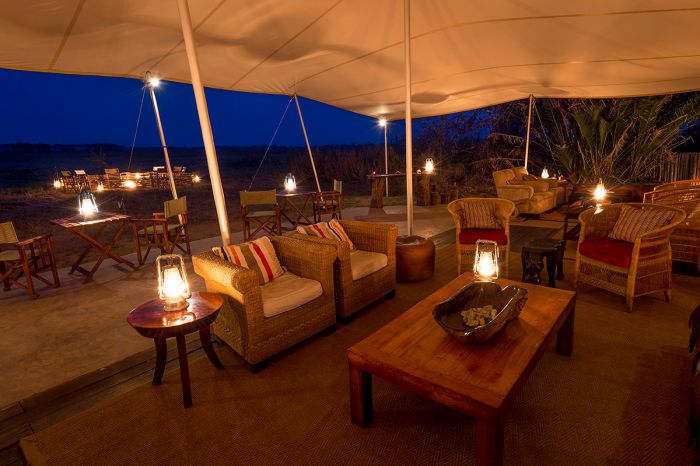
View from the lounge at Busanga Bush Camp.
Busanga Bush Camp offers just 4 Meru-style guest tents, each with views onto the open floodplain in front of the camp. The tentes are connected to the main camp area by sandy footpaths on the ground. Each guest test also offers an outdoor viewing deck chairs. The name 'Busanga' is derived from the local Bissa dialect expression "Bissa gwaa" (meaning "Bissa man").
The main camp area is constructed atop a ground-level wooden deck and includes a canvas-covered lounge and bar area with an outdoor dining area (dining moved under canvas in case of rain) looking out on the Busanga Plains.
Wilderness Safaris are one of Africa's leading safari operators and they strive to minimize energy consumption at all their camps. Busanga Camp is powered by a combination of diesel generators and large batteries with inverters and chargers. Water is heated by solar-powered geysers. Strict eco-friendly environmental standards are maintained so that no harmful chemicals or waste is allowed to enter the pristine ecosystem of the Busanga and Kafue.
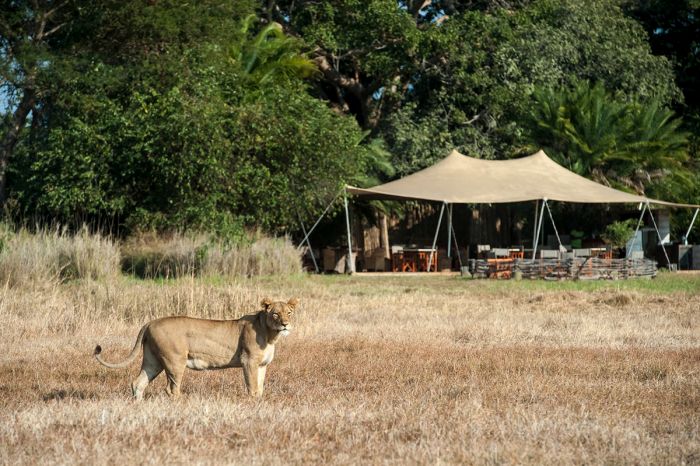
A lioness on the plain in front of the camp.
About Kafue National Park
Kafue is Zambia's largest national park, covering 8 650 square miles (22 400 sq kms). It is named for the Kafue River, which traverses the northern section of the park. Kafue was established by the British as a game reserve in 1924 (when the country was a protectorate called Northern Rhodesia) to stem the decline of its wildlife due to over-hunting. At that time, the reserve consisted solely of the northern portion of today's national park. The southern portion of Kafue was added to the reserve in 1949 and the combined land became a national park in 1950.
Elephant and rhino poaching decimated all of Zambia's reserves and national parks during its heyday in the 1970s and 1980s, but the remoteness of Kafue meant that is was spared the worst of the slaughter. During the 1960s, Kafue was home to around 60 000 elephants, but most were poached by the late 1980s. Today Kafue's elephant population is estimated at around 4 000. Kafue also had one of the largest black rhino populations in Africa, but they were all killed of for their horns by 1990. Today poaching is not a serious problem in Kafue.
Kafue is so large that there are completely different ecotones within its borders. The northern part of Kafue is characterized by several significant rivers, the Kafue, the Lunga, and the Lufupa. These waterways make northern Kafue a wetter and more vegetated destination for wildlife than the much drier southern part of the park.
Northern Kafue is dominated by miombo woodland, small areas of teak forest, mopane woodland, bushy thickets, open grassland, and seasonally flooded plains. The most significant wildlife-viewing region in the park is called the Busanga Plains, a vast area in the extreme north of the park along the Lufupa River.
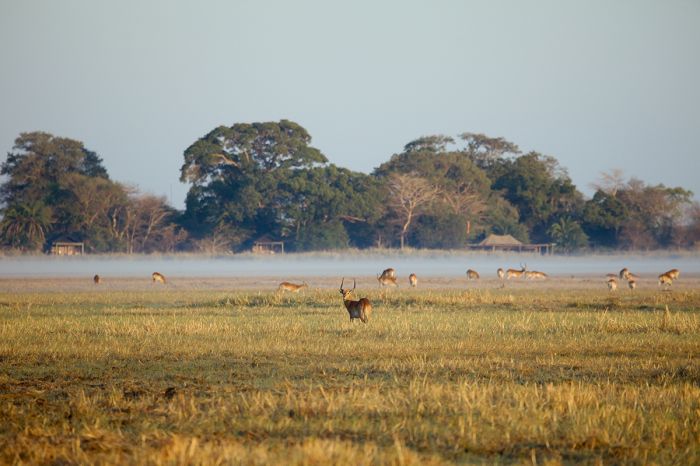
Red lechwe antelopes in front of Busanga Bush Camp.
The Busanga Plains
The Busanga Plains are a large area of seasonally flooded grasslands, waterways, and permanent swamps in northwest Kafue. This dynamic savanna ecosystem, which becomes dry grassland for part of the year, while completely flooded in shallow water the rest of the year, covers over 230 square miles (600 sq kms). During the dry winter months between June and October, the floodwaters recede leaving behind sediments that create a savanna of nutrient-rich grasses.
During this time, large numbers of grazers arrive to feed on the new growth, including herds of buffalo and good numbers of red lechwe, puku, Lichtenstein’s hartebeest, zebra, oribi, and blue wildebeest. Roan antelope, sable antelope and greater kudu are sometimes seen.
Predators are also found in Busanga at this time, including lion, cheetah, spotted hyena, side-striped jackal, serval, and Africa wild dog. Elephants are present in Busanga all year, but especially during the winter. Hippos are abundant in the permanent waterways and lagoons.
The landscape in Busanga is similar in many ways to that of Botswana's Okavango Delta, with date palm islands, termite mounds, tall Phoenix palms, baobab trees, and sycamore fig trees dotting the seemingly endless grasslands.
There are two safari camps located in the Busanga area, both of them operated by Wilderness Safaris, one of Africa's largest and best respected safari operators. The camps are open for guests only during the dry season between June and October.
ROOMS INCLUDES & EXCLUDES CHILDREN FACILITIES ACTIVITIES
Accommodation
4 guest accommodations in total comprising:
- 4 twin-bedded, Meru-style canvas tents, each with two three-quarter beds. Mattress converters are available that transform twin beds into a king-size beds (to be arranged prior to arrival).
Each tented accommodation is constructed atop a ground-level wooden deck with views the floodplain in front of camp. All tents have en-suite facilities consisting of an indoor shower, single-basin vanity, and toilet.
The guest tents are connected to the main camp area by sandy pathways on the ground.
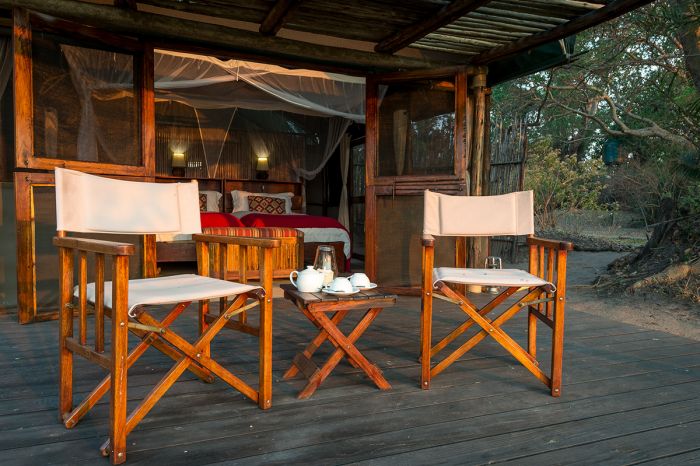
Guest tent at Busanga Bush Camp.
Guest tent amenities include a writing desk and chair, an outside deck with chairs and small table, and mosquito netting for the beds. During winter months, hot water bottles and extra blankets are provided.
Other items and features in the guest units include:
- Electronic safe.
- In-tent Wi-Fi.
- Personal amenities, including bathrobes, liquid soap, shampoo and conditioner, body lotion, insect repellent, shower caps, vanity kit with cotton-tip swabs, cotton balls, tissue dispenser, washing powder for optional in-tent garment washing, room spray, mosquito coil, and umbrella.
Busanga Bush Camp can accommodate a maximum of 8 guests in total: 2 persons in each of the 4 tents.
Includes & Excludes
Includes:
- All meals and local beverages including wines, spirits and liqueurs, but excluding premium imported brands and Champagne.
- Twice-daily safari drives in open game-viewing vehicles and other scheduled camp activities (accompanied by experienced guides).
- Laundry services are provided on a daily basis (weather permitting, items will be returned on the same day). Laundry is dried by the sun and on most days any laundry placed out in the morning will be returned by the evening.
- Wi-Fi access.
- Local government taxes.
Excludes:
- Premium imported beverages and Champagne.
- Any applicable wildlife fee, park fee, reserve fee, concession fee, other land-use fee.
Single Supplement
A single supplement will apply for any room booked by a single traveler; please ask us for pricing.
Children
Children aged 6 years and older are accommodated at Shumba:
- For families traveling with children between 6 and 12 years, private activities are not a requirement, as families are accommodated on vehicles with other guests (Busanga Bush Camp being an Adventures category of camp).
- Children between 6 and 16 years must share with an adult/s in the same room.
- The minimum age for boating activities is 6 years (water levels permitting).
Facilities
- Lounge and bar areas under canvas on a ground-level wooden deck, under a canopy of trees.
- Dining is outside unless it is raining.
- Sunset deck for private dining for small groups.
- Viewing platform for sundowner drinks in the evenings and early morning teas.
- During winter months, knee blankets are provided during dinner.
- Traditional boma for dining under the stars.
- Campfire area with seating.
- Spotting scope.
- Guest toilet in main area.
At Busanga Bush Camp, guests will need to hand their batteries to the camp staff for charging in either the main area or office while out on morning activities. It is, therefore, advisable to carry spare batteries.
Activities
Activities included in the rate:
- Day and night game drives in 1x 10-seater Toyota Hilux. For an Adventures category of camp, in open game drive vehicles, no more than nine guests per vehicle (with seven “window” seats) if the numbers are made up of different booking parties.
- Blankets and lined ponchos are provided on cold mornings.
- A pair of Olympus binoculars is available in the game drive vehicle for guests to share amongst themselves whilst game viewing and may be requested from our guides.
- Water-based activities in 1x 6-seater boat (water levels permitting and mostly at the beginning of the season).
- Birding.
- Stargazing with a laser pointer.
Optional activities at additional cost:
- Private activities on offer (subject to vehicle availability, which needs to be booked and paid for in advance). Note that the one private vehicle on the Busanga Plains Concession and it is shared between Shumba Camp and Busanga Bush Camp.
Example of a typical day:
- Early morning wake-up call. Morning wake-up and activity times vary according to the seasons, activities on offer, and wildlife sightings.
- Light breakfast before departing on the morning activity.
- Return to camp for a meal and rest period.
- Meet for afternoon tea and snacks (savory and sweet choices) before departing on the activity.
- Return to camp - freshen up or meet for drinks, followed by dinner.
- Enjoy a nightcap or discussion around the fire before retiring.
Great Good Fair Poor
- Jan
- Feb
- Mar
- Apr
- May
- Jun
- Jul
- Aug
- Sep
- Oct
- Nov
- Dec
Best Time To Visit
The Busanga Plains are a seasonally flooded grassland and the game driving tracks become impassable due to the rising water from sometime in November through mid-May (precise timing depends on the rainwater entering the river systems, as well as local rainfall in northern Kafue National Park. For this reason, the camps in the Busanga are only open during the dry winter months from June through October.
July through mid-October is the prime time to visit Busanga for wildlife viewing.
Local rains in northern Kafue fall mainly between November and March, with December thru February receiving by far the highest amount of precipitation. Late October and early April may also get some sporadic rain. Between May and mid October, rainfall is rare to non-existent.
Busanga Bush Camp is open from 01 June to 31 October.
Climate
Temperatures in northern Kafue and Busanga are pleasant to warm all year, but there is some variation. The dry, winter months of June and July are the coolest time of the year, with daytime temps averaging 75-78°F (24-25°C) and nights dropping to 40-45°F (4-7°C).
August and September are mild and completely dry and are prime time to visit for wildlife in Busanga. The landscape becomes dry in most places, although the rich Busanga Plains still hold water, making it an outstanding place for wildlife. Temperatures warm up slightly, averaging daytime highs of 85-90°F (29-32°C). Overnight temps average 50-55°F (10-13°C).
October is hot and dry in the Busanga, with excellent game viewing. Temperatures climb to 89-93°F (32-34°C) during the day and nights are comfortable at 58-63°F (14-17°C). Early rains are possible at the end of October.
November through March is the rainy season in northern Kafue. Safari camps in the Busanga Plains region are closed, as the area becomes flooded and the roads submerged. Daytime temperatures average 86-88°F (30-31°C). April sees an end to the rains and the bush is spectacularly verdant, but the floods need time to recede before the game drive tracks become passable.




